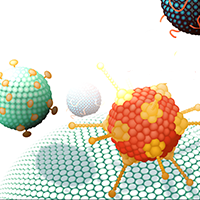Keeping viral vector manufacturing in-house: strategic considerations for gene therapy biotechs
Cell Gene Therapy Insights 2018; 4(10), 965-968.
10.18609/cgti.2018.095

TIMOTHY J MILLER PhD, is co-Founder, President and Chief Scientific Officer of Abeona Therapeutics Inc. He has over 20 years of business development, scientific research, product development and clinical operations expertise, with a focus on transitioning novel biotherapeutics through pre-clinical phases and Phase 3 human clinical trials. As a C-level executive in public and private companies, he has driven multiple inflection points through innovation and operational excellence in rare disease companies. Dr Miller was President and CEO of Red5 Pharmaceuticals from 2013 until 2015 and was CEO-in-Residence at BioEnterprise Inc. in 2015. He was Senior Director of Product Development at SironRX Therapeutics from 2010 to 2013. Between 1996 and 2010 Dr Miller held various positions at several biotech companies focusing on gene therapy and regenerative medicine. Dr Miller earned his PhD in Pharmacology with a focus on gene therapy/cystic fibrosis from Case Western University. He also holds a BS in Biology and MS in Molecular Biology from John Carroll University (Cleveland, OH, USA).
Abeona Therapeutics recently opened a new commercial gene therapy manufacturing facility in Cleveland. Can you tell us about the strategic drivers that led to the company deciding to ‘go it alone’ by establishing its own manufacturing capabilities?
TM: Manufacturing expertise in gene therapy is one of the key rate-limiting steps in getting into IND-enabling studies and through clinical trials, and onwards towards pivotal studies and commercialization.
As we looked to the future and considered the depth of our AAV pipeline, we wanted the ability to control our manufacturing timelines. With the benefit of cost savings and accelerated scale-up for assay development, this has helped us risk mitigate – as an example, this has helped us ensure alignment across multiple programs by streamlining release standards of an active, infectious virus.
Gene therapy is rapidly evolving both in terms of the technology and demand for vector production capacity – how have you sought to ensure this facility can help Abeona Therapeutics move with the times?
TM: The Elisa Linton Cell and Gene Therapy manufacturing facility has the capacity for both cell and gene therapies with multiple independent suites, so we are able to manufacture at multiple scales for multiple programmes.
It’s a gene and cell therapy facility, with the ability to manufacture both products – and our discussions with regulators regarding the design of the facility have been very helpful with our recent commissioning.
We can perform scale-up for main vector capsid platform, which allows us to go from very small scale to in vitro studies, and onwards through IND-enabling toxicology studies and non-human primate studies to clinical capacity and eventually, full commercial production.
What words of advice would you have for other biotechs considering establishing an in-house commercial GMP vector manufacturing facility?
TM: The ability to establish an in-house GMP manufacturing facility is built on the expertise of the personnel and staff. Recruiting top-tier talent that understands the ins and outs of gene and cell therapy manufacturing and implications of recent guidance is a critical element of success for a GMP manufacturing facility.
It’s also important to choose where and how you build out – whether you will renovate an existing building or build out in a greenfield space, for example. You have to plan 2–4 years out and think about both the capacity you’re going to need and your current financing.
The clinical advances of these products has helped gate of our decision process, and that led to us making the commitment to doing in-house GMP manufacturing.
You have specialized over the years in successfully transitioning biotherapeutic product candidates from preclinical into clinical studies – how have you brought that experience to bear with Abeona’s gene therapy candidates?
TM: Often the in-licensing process helps build relationships academic centers and companies, facilitating entry into an industrial setting. At that point in development, many programs have demonstrated a fair amount of proof of concept and efficacy data, but not as much safety data. By partnering, both groups leverage expertise to enhance and accelerate development of promising therapies.
One of the things I think we have specialized in at Abeona is the ability to develop our own preclinical pipeline candidates. That’s based on having a deep understanding of how the regulatory agencies – the FDA, or the EMA, or the TGA in Australia – each have certain guidelines for what they would like to see in these rare disease gene therapy programmes. Specifically, what kind of depth they require for dose ranging studies, what level of safety and toxicology studies, and how you can model these diseases in animals.
Looking to the future, what are Abeona Therapeutics’ key goals and priorities, both for 2019 and beyond?
TM: In 2019, Abeona will be manufacturing its own clinical- and commercial-grade AAV vectors, which will provide key support to our pipeline: we have a number of undisclosed disease targets right now that we’re developing gene therapies for and this facility is central to enabling those projects, and also expanding to additional pipeline targets.
And what can you tell us about the company’s activities at the cutting edge of next gen AAV vector R&D?
TM: We have our AAV gene therapy platform, which was originally in-licensed and has now gone through a second and third generation – we now have over 100 capsids that have advanced tissue specificity and selectivity.
So, if you want to do something for intra-muscular disease or a CNS-based disorder, where you want to go in systemically versus a direct clean administration, we have a number of these AIM AAV vectors that have these tropisms that will allow us to do second generation products. That’s important because as you look at the space, you see these non-natural capsids may help us get around some of the naturally occurring antibody resistance we’re seeing with more natural serotypes.
AFFILIATION
Timothy J Miller
Abeona Therapeutics, Inc
This work is licensed under a Creative Commons Attribution- NonCommercial – NoDerivatives 4.0 International License.

